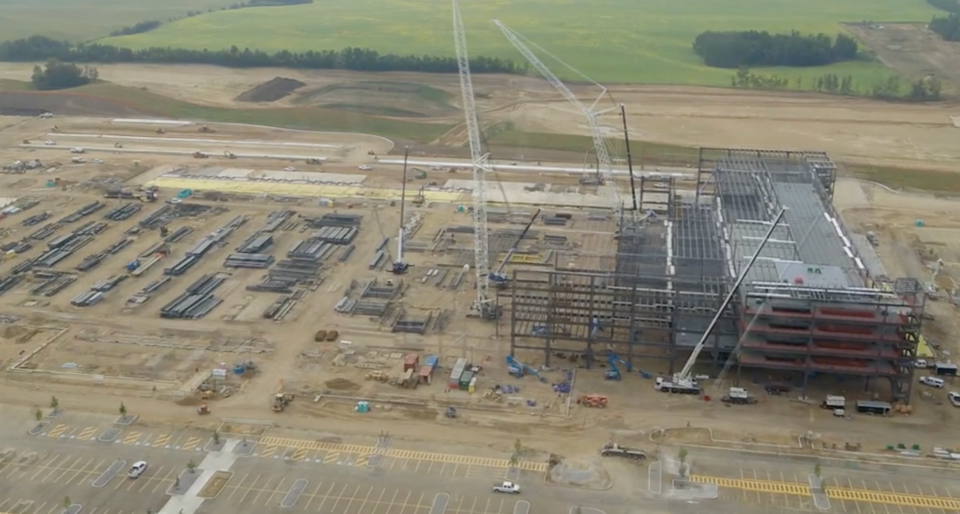Edmonton’s industrial vacancy rate has fallen by nearly a third over the past year as strong demand for logistics space continues.
The city saw nation-leading uptake of industrial space of nearly 3.8 million square feet in the third quarter, according to Colliers International. While much of it was from purpose-built space in two properties, strong demand helped pushed vacancies down to 4.2 per cent versus 6 per cent a year earlier.
“Industrial is heavily driven by distribution, logistics,” said Susan Thompson, associate director of research with Colliers, noting that demand is coming from within the province as well as beyond. “There are a lot of reasons companies are now considering utilizing that. … [You] have well-educated, skilled labour in Alberta. It tends to be more affordable on housing, on rental rates. You have the ability to develop as needed.”
While Edmonton continues to lead the country in terms of vacancies, the strong uptake in space points to ongoing demand despite challenges in segments of some other markets.
While strata industrial space in B.C. is facing headwinds from rising construction costs and longer decision-making timelines, the shortage of options for large-scale users for fulfilment centres has continued. People may be paring back spending, but they’re continuing to shop online and that’s supporting the need for new space to accommodate the demand.
The largest chunk of space absorbed in Edmonton during the third quarter was the 2.9 million-square-foot Amazon sortation facility which completed in the Acheson area.
There’s more to come, too, with 10 projects totaling 1.4 million square feet commenced during the quarter, including the Pioneer Skies Business Park Buildings 1 and 2 in the Leduc-Nisku submarket and two buildings at Fulton Creek Business Park in northwest Edmonton.
Demand also remains high in Calgary, where vacancies totaled 2.2 per cent in the quarter, down from 4.9 per cent a year ago.
“Given the lack of available inventory in the market, we’re also seeing inducement compression on new deals, with landlords becoming less willing to fund improvements or offer free rent to the extent that they may have in the past,” Colliers reported. “Pre-leasing on high-quality new developments is seeing strong interest from a variety of groups, both for recently completed buildings and planned or under construction projects.”
Concern about retaining access to space is so great that many tenants are signing renewals or new leases well in advance of their existing agreements expiring.
The torrid pace of industrial activity is in stark contrast to office demand.
Calgary’s office market continues to work through a large oversupply. Vacancies fell to 27.5 per cent during the quarter from 28.6 per cent a year ago even as companies continued to right-size space requirements. Subleases now account for 18.9 per cent of vacancies, down from 22.8 per cent a year ago.
High vacancies have limited new construction in Calgary, unlike in Edmonton where tenants are moving into space purpose-built for them. This has kept overall vacancies in check, falling to 19 per cent, despite some users returning significant blocks of space to the market.
“Office construction is either very specific to a tenant, or it’s for those professional services that are tied to population growth,” Thompson said. “Suburban seems quite popular with some companies because it better enables the return to office because there’s less reliance on public transit.”
The quarter saw 73,625 square feet of office space absorbed during the quarter, all but 148 square feet in suburban markets. But the downtown market is strengthening, with further activity expected now that workers have returned from summer holidays.
“For the first time since the start of the pandemic, two new office construction projects have been announced,” Colliers noted. “Canadian Western Bank Tower in the downtown core is expected to be approximately 350,000 square feet, with only 120,000 square feet vacant once CWB takes possession.”
The tower is set to complete in 2025.
The other project on the books is EVER Square, a 125,000-square-foot medical-office building under construction at Calgary Trail and Gateway Blvd. set to complete towards the end of 2023. The office component is 78,000 square feet.
The positive absorption led to Edmonton office vacancies staying in check at 19 per cent, down marginally from 19.4 per cent a year ago.



